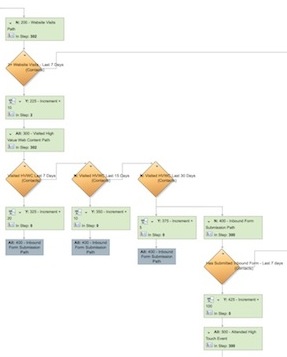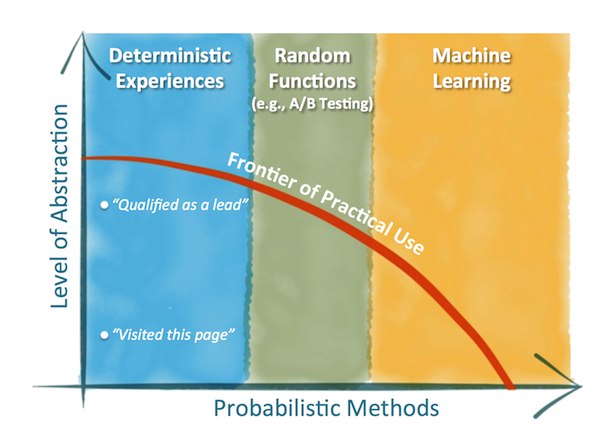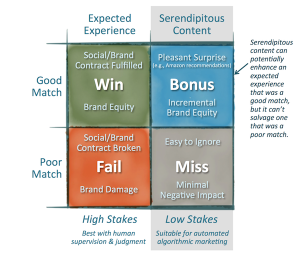If you were going to pick a representative image of marketing automation, it would surely be one of these flow-like diagrams:
If a customer visits this page, then send this email — if they’re a qualified lead — else wait 2 days and send them this other email — if we know their email address — else cookie them for display advertising retargeting.
And so on.
Being able to create and maintain these flows is one of the main reasons that marketers should learn how to program. It’s quintessential programmatic logic.
But it struck me the other day: this is not automation, this is experience design.
That may already be obvious to many of you — and the rest of you may think I’m splitting hairs — but this is not really about business process automation. This is about designing an experience that a prospect or customer will have. Increasingly, it’s an experience that crosses channels and spans a sequence of events in time.
Okay, technically speaking, it is automating a process. But if we’re going to be technical, almost everything that a computer does on our behalf is a kind of automation. Serving up web pages is an automation — you aren’t personally handling each request. But you don’t think of creating a website as an automation mission. You think of it, hopefully, as a user experience design mission.
Looking through a user-centric lens makes all the difference in the world. You’re making choices explicitly with the goal of how they will affect your audience, rather than being overly distracted by internal processes or the configuration mechanics of your marketing automation software.
For websites, there’s now nearly 20 years worth of user interface design knowledge that can be applied. But the experience design of marketing automation is still in its infancy — a nascent specialty in user experience design. But it’s clearly one that’s growing.
More about robots vs. marketers
Related to this, I want to follow up on my post on robots vs. marketers: the algorithmic marketing matrix. Because in this new kind of experience design, it matters what we’re relying on the software to do on our behalf.
In many ways, the term “algorithm” is as fuzzy as “automation.” A well-planned customer experience flow can be said to be following an algorithm — an explicit set of instructions — even though the decisions of what happens in that flow were 100% determined by a human. There’s no artificial intelligence involved.
To be more precise, I think we want to look at two dimensions in which marketing can be “automated” by software:
The X axis represents one dimension in which processes become more automated: through the use of probabilistic methods. Without probability, you have a deterministic process — if P happens, then do Q. Simple probabilistic functions are things likely randomly assigning users to different variations of an A/B test. More advanced probabilistic algorithms enable machine learning and artificial intelligence. As you go along this continuum, you turn over more decisions to the software.
The Y axis represents another dimension of automation: through an increased level of abstraction. Down near the bottom, the marketer works with very discrete events and conditions — e.g., a prospect visits a specific page on your website. As we go up this axis, we deal with higher-level concepts, such as checking a condition that someone has “qualified as a lead.” There may have been many components that contributed to that person becoming a lead, but we don’t have to explicitly check them there — the software helps us abstract those details away.
Marketing software can get more sophisticated and advanced along both of these axes. However, take care — more probabilistic methods and more abstraction are not always desirable.
As I pointed out with the algorithmic marketing matrix, introducing probability into a user’s experience can be dangerous. In scenarios where a prospect or customer has expectations about an experience, you don’t want to leave the outcome to chance.
On the other hand, in scenarios where serendipity can apply, it makes tremendous sense to harness the power of machine learning.
Machine learning techniques are also relatively safe if they’re being used in back-office marketing work, to help sort through the heap of big data and identify new opportunities for customer segmentation and targeted campaigns. Eventually this results in front-office marketing, but human judgment and supervision intervenes in the translation.
In a similar way, abstraction can be good — it lets us design and monitor higher level flows of our business — but we have to be careful not to abstract away the user experience. The boxes and lines on your screen when you’re designing a marketing automation flow will become actual customer experiences.
Even with abstractions that a customer will never directly see — such as a “is this person a qualified lead?” condition — it’s prudent to check in on the lower-level details from time to time. What are the rules that contribute to a qualified lead? Are they overstated? Or maybe understated? Have they been updated to reflect changes elsewhere in your marketing programs? Trust but verify those handy abstractions.
You can mix abstraction and probabilistic methods, but the caveats of each are multiplied. You can get into some strange territory when machine learning algorithms are attempting to determine the high-level abstractions of your business.
This give us a frontier of practical use — the line between theory and practice, perhaps? — that is constantly being advanced.
But going back to the opening point of this article — that marketing automation is really experience design — we should continually reaffirm that the area below the curve of that frontier of practical use is solid, not hollow.






Interesting article Scott!
The importance of this to marketers can not be emphasized enough as marketing technology increasingly impacts the customer experience and marketing responsibilities are blurred with the rest of the enterprise.
Thanks, Amy. “Everything is marketing.”
I wonder if at some level, that all labor that creates value is, in essence, either (a) user-experience design or (b) user-experience execution.
That’s a very meta-level view. I like it.
Your article resurfaced for me recently, and I’m leaning towards the idea that your Marketers that are running the Marketing Automation platform are actually “Marketing Engineers” rather than “Marketing Ops”. I’m allude to this concept on my company’s blog: http://blog.newrelic.com/2014/06/25/marketo/
Scott,
This is great stuff, it scratches my brain in a unique way. Thank you.
Allen Roberts
Thanks, Allen. I’m always happy to hear that someone else finds these things as intriguing as I do.
Scott,
Nice article. I believe that everything we do as marketers requires some sort of logical flow / decision analysis behind the scenes. For every part of the mix we are designing a prospect or customer journey, whether that be through a marketing program, display advertising or routes through a website, for example. If the end goal of a marketing activity is tightly defined and the route to it is well structured, most marketers will be subconsciously using this type of flow chart logic. It’s just that they probably don’t realise it or document it as a flow chart. It sounds less scary to most marketers when you think about it that way!
Thanks, Maria.
It makes sense to me that many marketers would have a natural tendency to think of “flows.” That seems to feed the creative process. What are stories if not flows? And as Seth Godin would say, all marketers tell stories.
Drawing them out as actual flow diagrams is an approach that has clearly been imported by the software folks building marketing applications. It does have the benefit of being easy to communicate to others with a high degree of precision — whereas stories tend leave more open to imagination and interpretation. But because it is a foreign way of documenting things, I do think there’s a risk of getting caught up in the mechanics of the flow diagram and losing the spirit of the story.
“Marketing Automation” is a terrible term. I admit I focus heavily on process design with any MA initiative. Too often companies don’t have a process, or it’s incredibly basic and any process design is better than the incumbent status.
I really like how you turn process design 90 degrees and emphasize it’s about supporting the customer experience. With any “process” different customers require a different experience at different stages of their engagement. And the outcomes will vary. When we (myself included) try to jam everyone into the same process, the experience is ignored which ultimately impacts the outcomes.
This is my favorite quote in your post: “This is about designing an experience…it’s an experience that crosses channels and spans a sequence of events in time.”
Thanks for shifting my paradigm a bit!
Cheers,
BH
Thanks, Brian.
You raise a really good point. While the customer experience portion of this is important, it is also the case that scaling marketing in this new environment requires good internal processes too. Process without an eye towards experience risks the customer being underwhelmed; but experiences without process risk chaos.
I really appreciated everything you wrote here. Really gave me a lot to think about. Great post!
Great post Scott, thanks. It make me think about a quote by Bill Gates regarding automation : ”The first rule of any technology used in a business is that automation applied to an efficient operation will magnify the efficiency. The second is that automation applied to an inefficient operation will magnify the inefficiency.”
This is where experience matters as you stated.